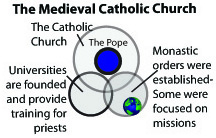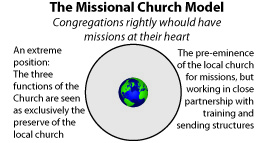How seriously has the church and its leaders taken the Great Commission, the last command of our Lord on earth? Only sporadically has there been bursts of obedient leaders who gave up everything to fulfill Christ’s desire. Burnett gives the following outline in the “Future of the Global Church” (p. 225).
 Jesus’ ministry left some models but few instructions. It was like He wanted us to use our ingenuity and guidance of the Holy Spirit, while keeping His priorities and basic functions. The three functions of “gathering, training and sending” in equal balance. The Early Church before 70 AD was mostly around the Temple or synagogues until church bodies formed for celebration and training. Once the Jewish element disappeared the church tried to emulate the earlier model in the midst of persecution.
Jesus’ ministry left some models but few instructions. It was like He wanted us to use our ingenuity and guidance of the Holy Spirit, while keeping His priorities and basic functions. The three functions of “gathering, training and sending” in equal balance. The Early Church before 70 AD was mostly around the Temple or synagogues until church bodies formed for celebration and training. Once the Jewish element disappeared the church tried to emulate the earlier model in the midst of persecution.

Eventually, the western church become a rich and powerful institution with absolute papal and imperial authority and sought to defend and militantly expand a Christian empire. The universities were established in the Middle Ages to “provide a more educated priesthood” upon whom the uneducated masses depended. The lost world was relegated to the sole domain of a few monastic orders. The world was no longer the focus of the church. This model was hard to break.
 With the Reformation of the 16th century biblical theology was recovered, although details of theology became the priority rather than obedience to the purpose and commands for the Church. Too much of the old Church structure carried over with the focus on itself. By rejecting monasticism there remained no entity dedicated to the Great Commission for nearly 300 years. Some called this period the “deformation” or “the Great Omission.” God raised up the Moravians, outside the main Protestant church structures, to awaken the church to its global mission. This led to an awakening of the Evangelical church to engage the world with the gospel in the early 1800’s.
With the Reformation of the 16th century biblical theology was recovered, although details of theology became the priority rather than obedience to the purpose and commands for the Church. Too much of the old Church structure carried over with the focus on itself. By rejecting monasticism there remained no entity dedicated to the Great Commission for nearly 300 years. Some called this period the “deformation” or “the Great Omission.” God raised up the Moravians, outside the main Protestant church structures, to awaken the church to its global mission. This led to an awakening of the Evangelical church to engage the world with the gospel in the early 1800’s.
 For the next 200 years the Protestant church spread the gospel around the world; however, all three functions of the Church developed independently, usually autonomously. The parachurch organizations bled off church leadership and resources. With the rise of globalization and short-term ministries and the internet, churches began to want more engagement in the deployment of its members.
For the next 200 years the Protestant church spread the gospel around the world; however, all three functions of the Church developed independently, usually autonomously. The parachurch organizations bled off church leadership and resources. With the rise of globalization and short-term ministries and the internet, churches began to want more engagement in the deployment of its members.
 During the 1990’s the missional church concept spread while exaggerating its position as housing and controlling all functions of the ministry, practically condemning all parachurch organizations as unscriptural. The Acts 1:8 four-fold focus on ministry and missions and the practical application of these principles in the Acts 13 Antioch church would indicate a balance between the local church ministry and the “extra-church” apostolic ministry that remained linked and accountable to the local church. This leads us to the last model which is remarkably similar to the first model.
During the 1990’s the missional church concept spread while exaggerating its position as housing and controlling all functions of the ministry, practically condemning all parachurch organizations as unscriptural. The Acts 1:8 four-fold focus on ministry and missions and the practical application of these principles in the Acts 13 Antioch church would indicate a balance between the local church ministry and the “extra-church” apostolic ministry that remained linked and accountable to the local church. This leads us to the last model which is remarkably similar to the first model.
The 21st century is witnessing a call to return to the original balance of the three-fold functions with shared participation and jointly facilitating the other functions under the focus of obeying Christ’s last command. The Body of Christ maintains all its functions in its pursuit to form worshiping disciples among all the people groups around the world. Everyone gets to participate as God has gifted them in each of these functions.

